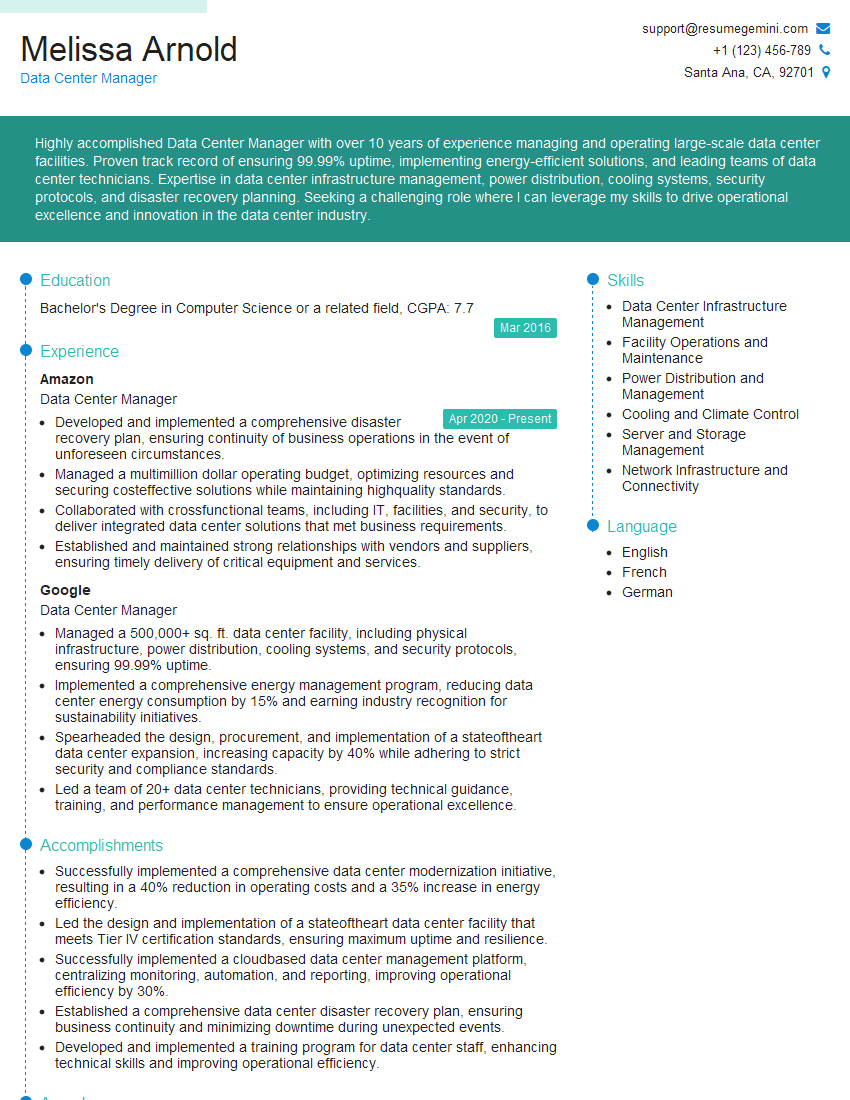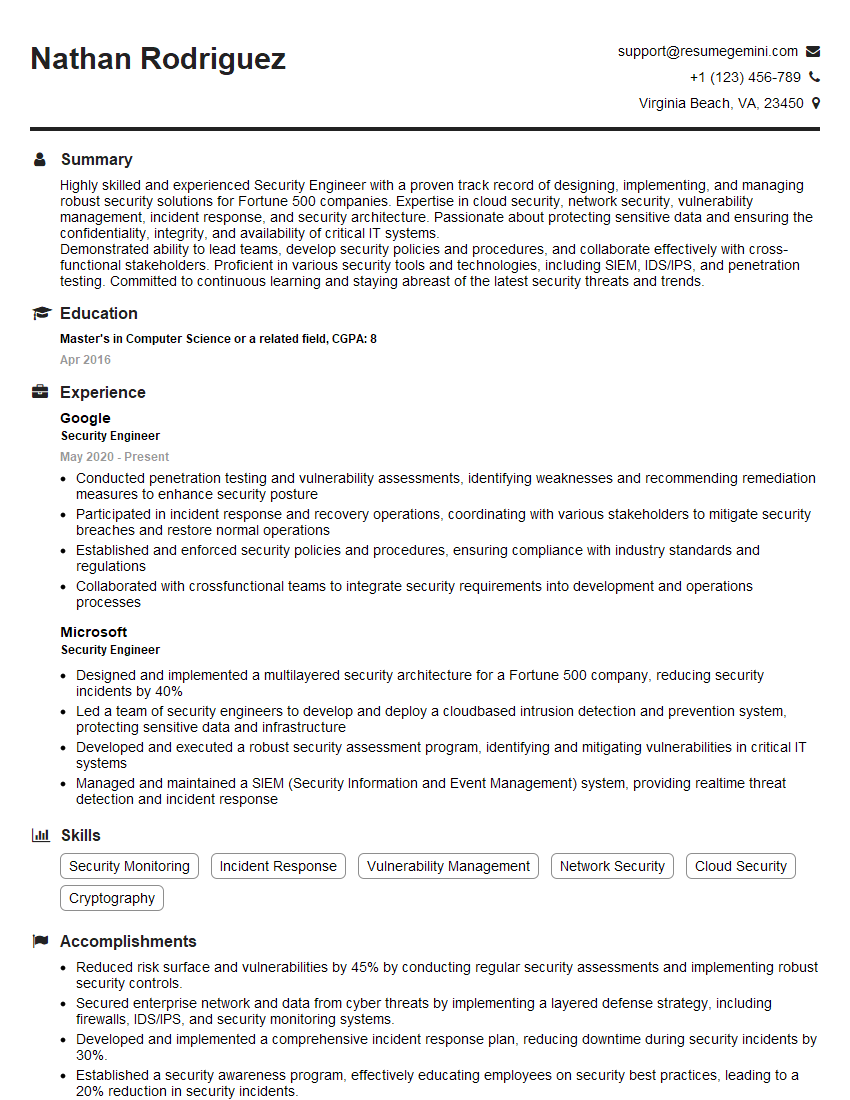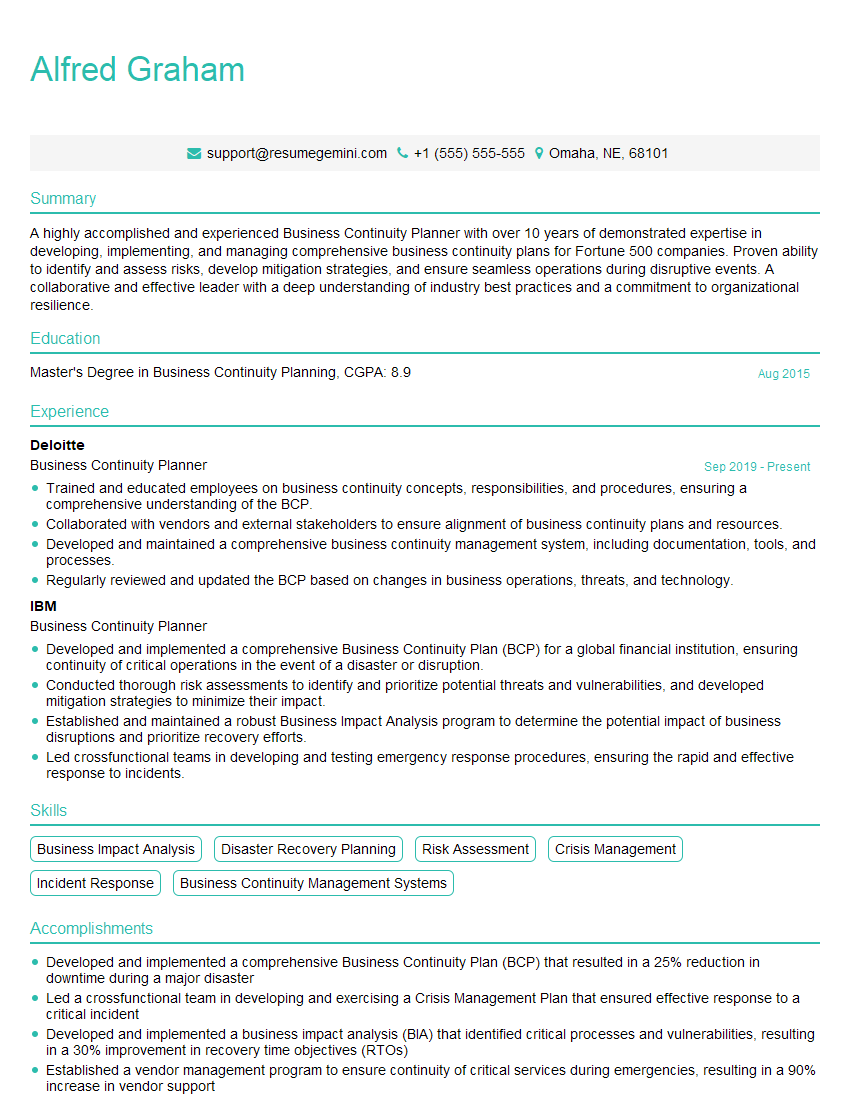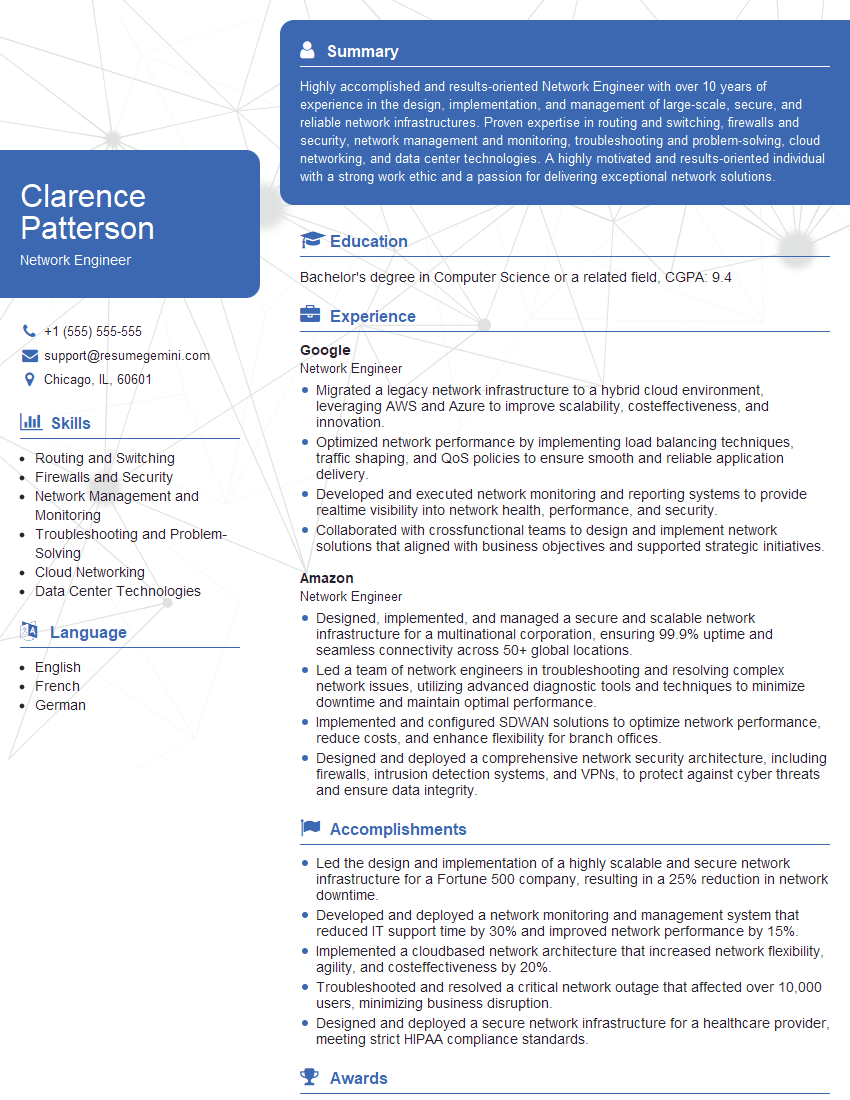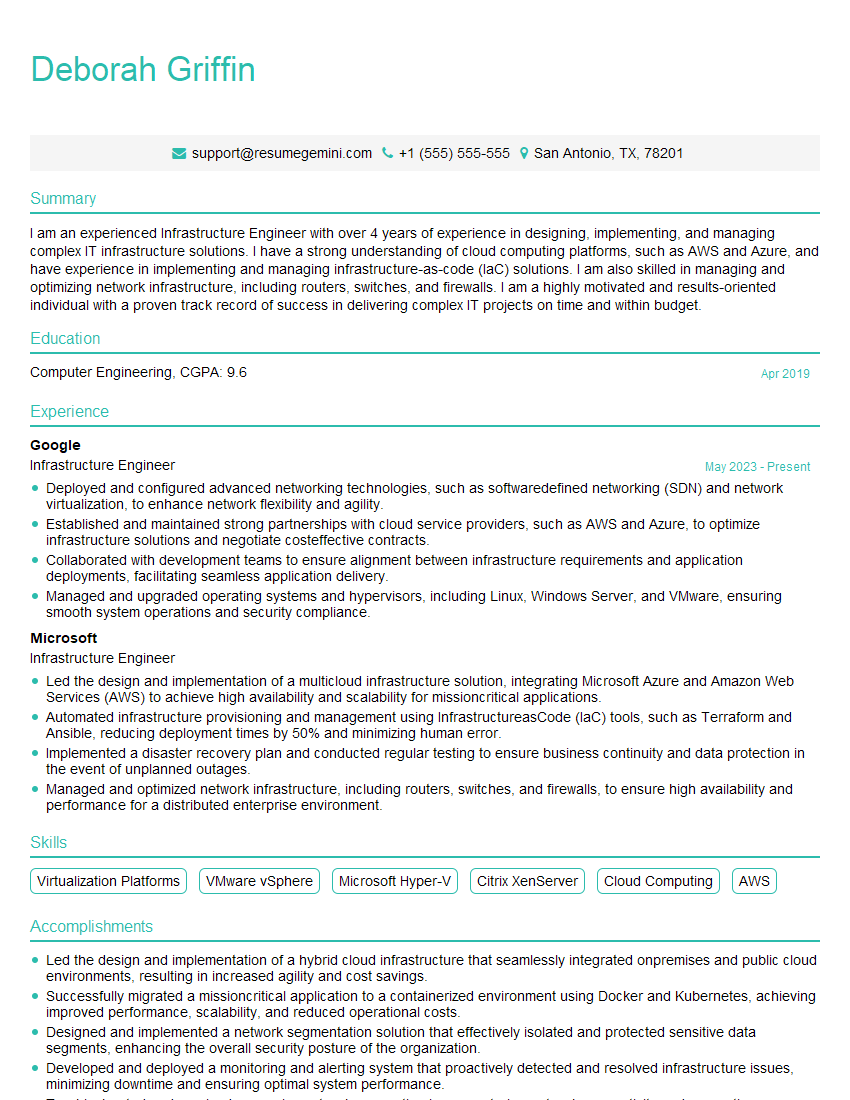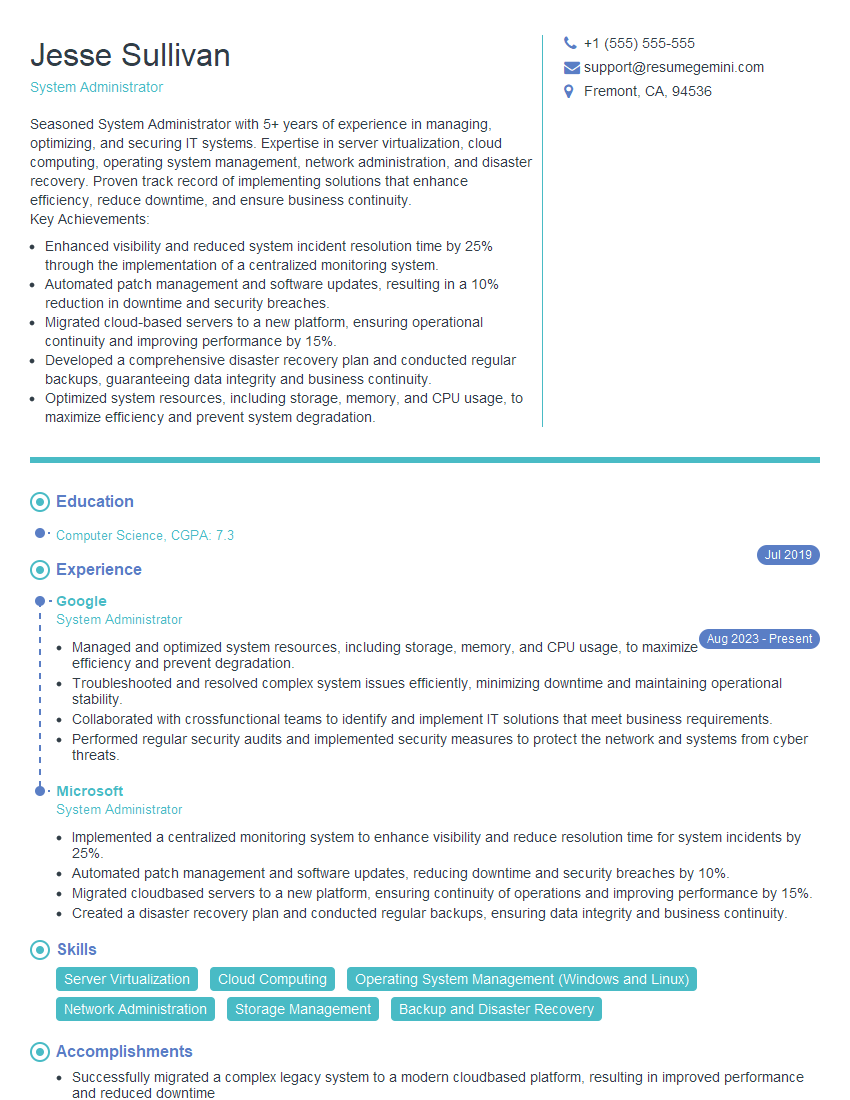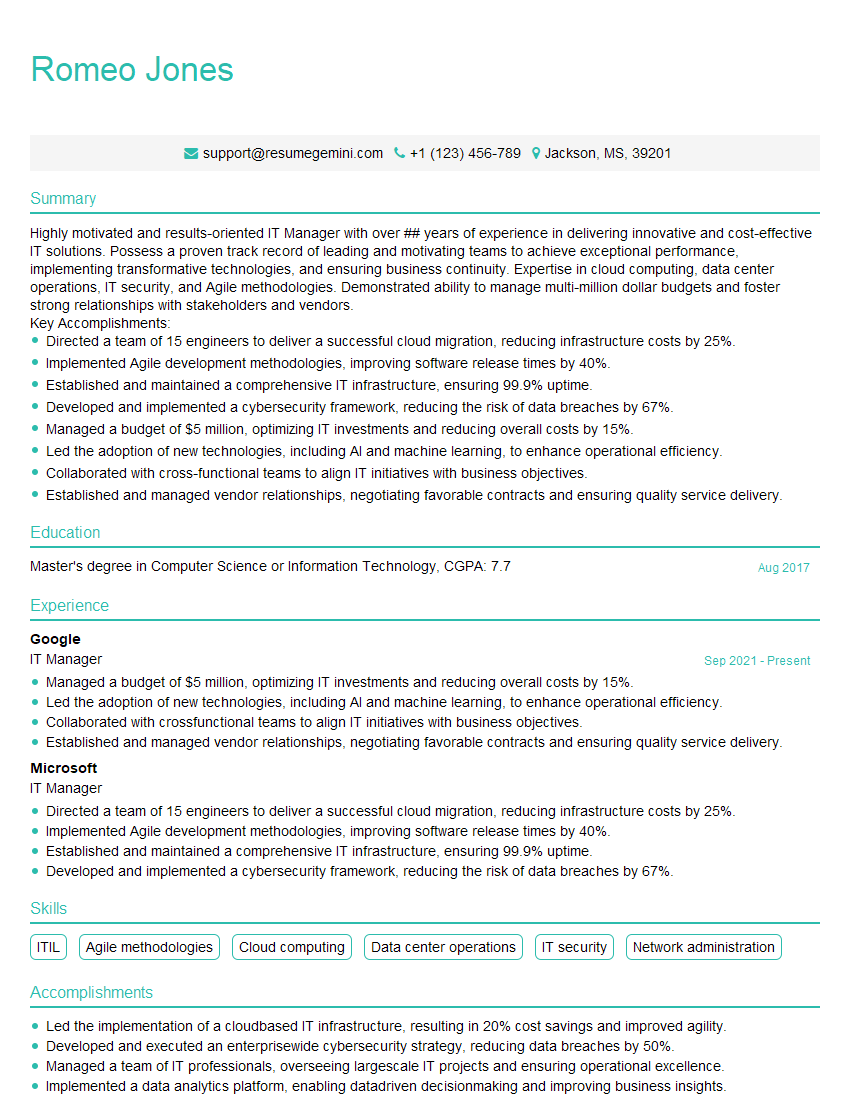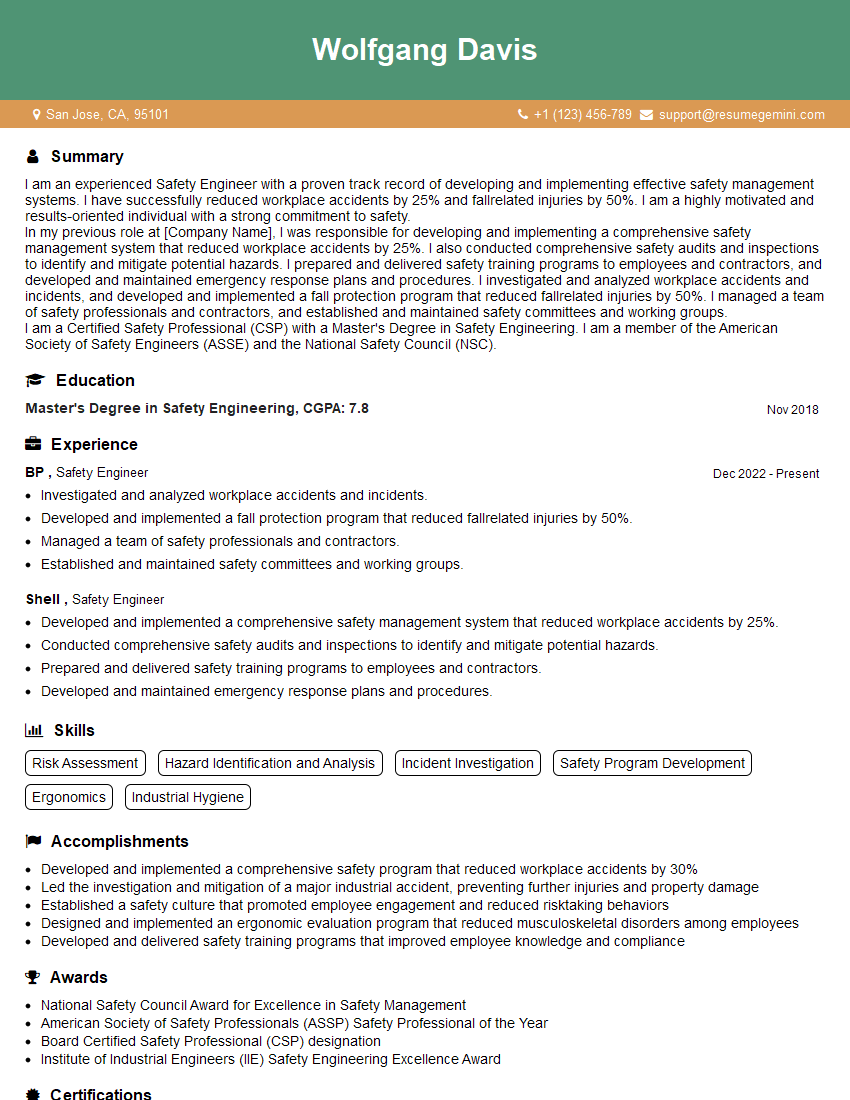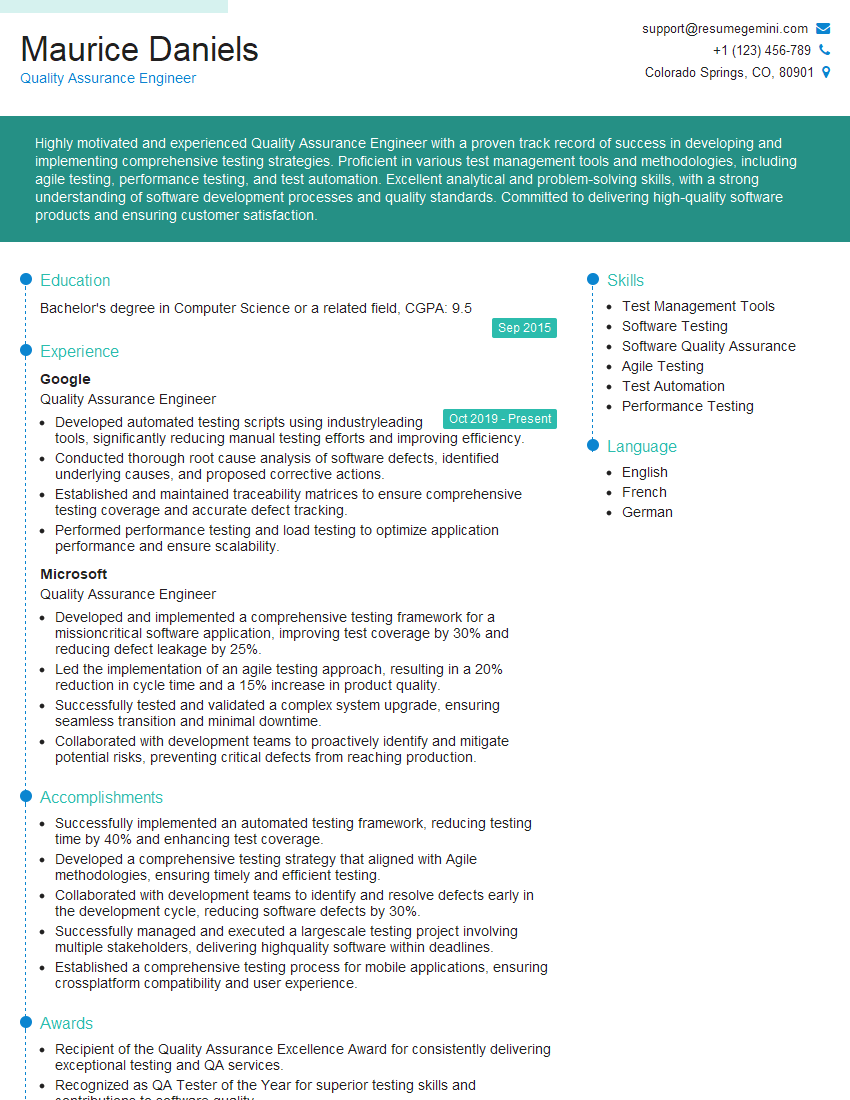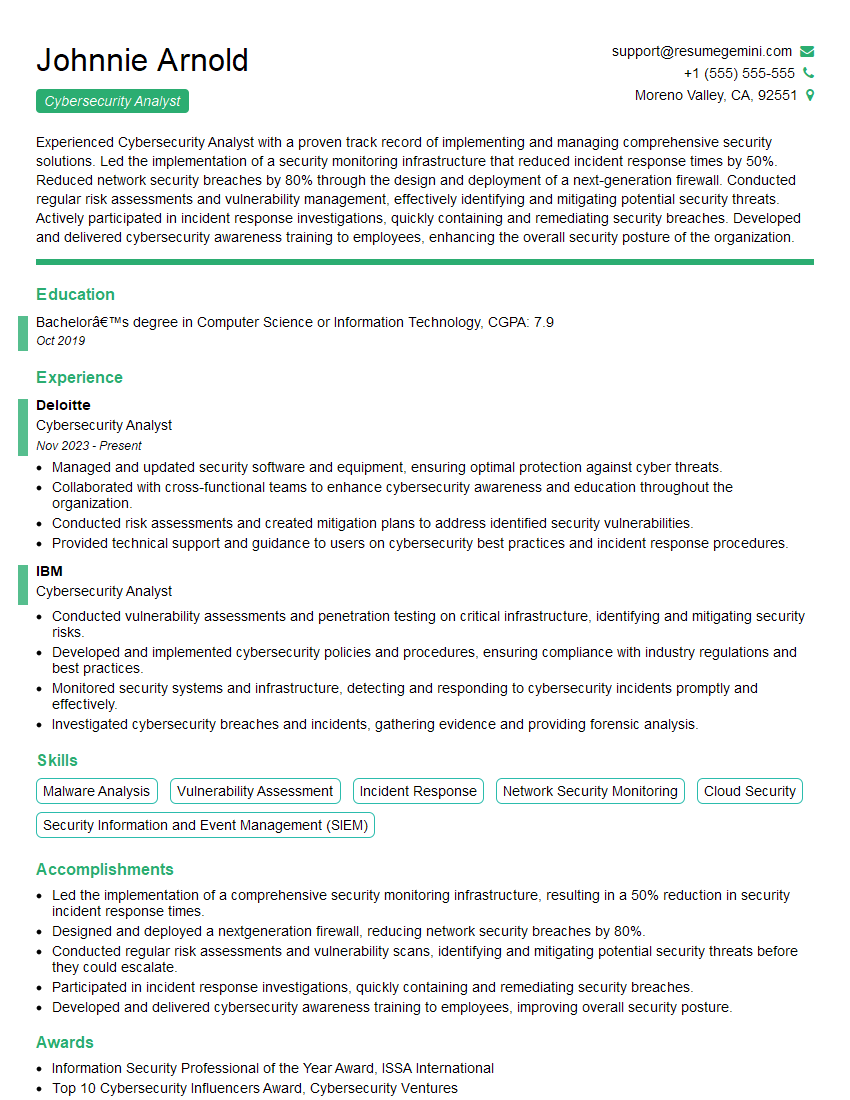Interviews are more than just a Q&A session—they’re a chance to prove your worth. This blog dives into essential Stability and Damage Control interview questions and expert tips to help you align your answers with what hiring managers are looking for. Start preparing to shine!
Questions Asked in Stability and Damage Control Interview
Q 1. Describe your experience in identifying potential system instability.
Identifying potential system instability involves a proactive and multifaceted approach. It’s not just about reacting to failures but anticipating them. My strategy combines monitoring, analysis, and a deep understanding of the system’s architecture and its dependencies.
- Continuous Monitoring: I rely heavily on real-time monitoring tools to track key performance indicators (KPIs) like CPU utilization, memory usage, network latency, and error rates. Significant deviations from established baselines trigger alerts, prompting investigation.
- Log Analysis: Thorough analysis of system logs is crucial. I look for patterns, recurring errors, and unusual activity that might indicate underlying problems. For example, frequent database connection timeouts could foreshadow a larger database issue.
- Capacity Planning: Proactive capacity planning is essential. By projecting future demand and resource consumption, I can identify potential bottlenecks and plan for scaling or upgrades before they impact stability.
- Stress Testing and Simulations: Regular stress tests and simulations, mimicking real-world scenarios, help identify vulnerabilities and weak points in the system. This allows us to address issues before they cause widespread disruption.
For example, during my time at [Previous Company Name], we used a combination of Prometheus and Grafana to monitor our microservices architecture. Early detection of an increasing number of 500 errors in one service, coupled with rising CPU usage, allowed us to preemptively scale that service and avoid a major incident.
Q 2. Explain your approach to mitigating risks associated with system failures.
Mitigating risks associated with system failures requires a layered approach that focuses on prevention, detection, and recovery.
- Prevention: This involves implementing robust design principles, including fault tolerance and redundancy (discussed in more detail later). It also means adhering to best practices in coding, configuration, and deployment.
- Detection: Employing comprehensive monitoring and alerting systems allows for early detection of anomalies. Automated checks and threshold-based alerts help to minimize the impact of potential failures.
- Recovery: Having a well-defined incident response plan, including rollback procedures and disaster recovery strategies, is paramount. Regular drills and testing ensure that the plan is effective and that the team is prepared.
Imagine a power outage scenario. Prevention could involve having redundant power sources (generators). Detection might be automated sensors that notify us of the power failure. Recovery would be our pre-defined plan to switch over to the backup power supply and minimize downtime.
Q 3. How do you prioritize incident response based on impact and urgency?
Prioritizing incident response requires a structured approach that considers both impact and urgency. I often use a prioritization matrix based on these two factors.
Impact refers to the scope and severity of the incident. High impact incidents might involve complete system outages, data loss, or significant security breaches. Low impact incidents might be minor performance degradations affecting a small number of users.
Urgency refers to the time sensitivity of the issue. High urgency issues demand immediate attention, such as a critical system failure impacting core business functions. Low urgency issues can often wait for scheduled maintenance windows.
I typically use a 2×2 matrix: High Impact/High Urgency (top priority), High Impact/Low Urgency (high priority), Low Impact/High Urgency (medium priority), and Low Impact/Low Urgency (low priority). This ensures that resources are allocated effectively to address the most critical issues first.
Q 4. What metrics do you use to measure system stability and reliability?
Measuring system stability and reliability involves tracking a range of metrics. These metrics provide insights into the health, performance, and resilience of the system.
- Mean Time To Failure (MTTF): The average time between failures. A higher MTTF indicates greater reliability.
- Mean Time To Recovery (MTTR): The average time it takes to recover from a failure. A lower MTTR reflects faster recovery and improved resilience.
- Uptime Percentage: The percentage of time the system is operational. Higher uptime is desirable.
- Error Rate: The frequency of errors or exceptions. Lower error rates indicate better system stability.
- Latency: The time it takes for the system to respond to requests. Lower latency signifies better performance.
- Throughput: The amount of work processed by the system in a given time. Higher throughput indicates better efficiency.
These metrics, when tracked and analyzed over time, provide valuable insights into trends and allow for proactive interventions to improve system stability and reliability.
Q 5. Describe a time you successfully prevented a system outage.
During a major system upgrade at [Previous Company Name], we were implementing a new version of our payment gateway. During testing, everything seemed fine, but shortly after the deployment to production, we started seeing intermittent failures and increased latency. I noticed a significant spike in database queries associated with a newly added feature.
My team quickly realized this feature was generating many unnecessary database calls, resulting in resource contention and impacting performance. We immediately rolled back the upgrade, temporarily disabling the problematic feature. We then implemented a more optimized solution and thoroughly tested it before redeploying it with no further issues. This proactive and quick response prevented a complete system outage and ensured uninterrupted service to our customers.
Q 6. Explain your understanding of fault tolerance and redundancy strategies.
Fault tolerance and redundancy strategies are crucial for building highly reliable and resilient systems. Fault tolerance is the ability of a system to continue operating even when some components fail. Redundancy is the duplication of critical components to ensure availability in case of failure.
- Redundant Servers: Having multiple servers running the same application ensures high availability. If one server fails, another takes over seamlessly.
- Load Balancers: Distribute traffic across multiple servers, preventing overload on any single server and enhancing resilience.
- Database Replication: Creating copies of the database on separate servers protects against data loss in case of a primary database failure.
- Backup and Recovery Systems: Regular backups and a well-defined recovery process allow for restoring the system to a working state in case of data corruption or disaster.
For instance, a cloud-based system often uses multiple availability zones, each with redundant servers and network infrastructure. If one zone fails, the application automatically switches to another zone, ensuring uninterrupted operation.
Q 7. How do you conduct root cause analysis of system failures?
Root cause analysis (RCA) is a systematic process used to identify the underlying cause of a system failure, not just the symptoms. It’s about understanding *why* the failure occurred, not just *what* happened. I typically use a structured approach like the 5 Whys.
The 5 Whys: Repeatedly asking ‘why’ helps to drill down to the root cause. For example:
- Symptom: System crashed.
- Why 1: Memory usage exceeded limits.
- Why 2: Memory leak in application X.
- Why 3: Bug in module Y of application X.
- Why 4: Inadequate testing of module Y.
- Why 5: Insufficient time allocated for testing.
The root cause is insufficient time allocated for testing. Addressing this will prevent future similar failures. Other RCA methodologies, such as Fishbone diagrams (Ishikawa diagrams) or Fault Tree Analysis (FTA), can also be employed depending on the complexity of the situation. The goal is always to prevent recurrence by addressing the root cause, not just the immediate symptoms.
Q 8. What tools and technologies are you familiar with for monitoring system health?
Monitoring system health requires a multi-faceted approach utilizing various tools and technologies. My experience encompasses a broad range, from basic system logs to sophisticated monitoring platforms.
- System Logging and Monitoring Tools: I’m proficient in using tools like Splunk, ELK stack (Elasticsearch, Logstash, Kibana), and Graylog for centralized log management and analysis. These allow me to proactively identify potential issues by correlating events and detecting anomalies in system behavior. For example, a sudden spike in error logs from a specific application server could indicate an impending failure.
- Infrastructure Monitoring Tools: Tools like Nagios, Prometheus, and Zabbix provide real-time monitoring of critical infrastructure components, such as servers, networks, and databases. They offer threshold-based alerts, enabling prompt intervention before minor issues escalate. Imagine a database server running low on disk space – these tools would trigger an alert, allowing us to proactively address the issue before it impacts application performance.
- Application Performance Monitoring (APM) Tools: Tools like Dynatrace, New Relic, and AppDynamics provide detailed insights into application performance, identifying bottlenecks and areas for optimization. They allow us to pinpoint slow queries, memory leaks, or other performance-related problems. For instance, we can identify a specific database query causing slow response times and optimize it for better efficiency.
- Synthetic Monitoring Tools: Tools such as Datadog and Uptrends simulate user activity to monitor application availability and performance from different geographical locations. This allows for proactive detection of potential outages or performance degradation before end-users experience any issues.
The choice of tools depends on the specific needs of the system and the organization. A holistic approach, leveraging a combination of these tools, ensures comprehensive system health monitoring.
Q 9. Describe your experience with disaster recovery planning and execution.
Disaster recovery planning and execution are critical aspects of my expertise. My approach involves a structured methodology that ensures business continuity in the face of unexpected events.
Planning Phase: This includes defining recovery time objectives (RTOs) and recovery point objectives (RPOs), identifying critical systems and applications, and developing detailed recovery procedures. We conduct regular drills and simulations to test the efficacy of our plans and identify areas for improvement. For example, a recent project involved designing a disaster recovery plan for a financial institution, where we prioritized the recovery of core banking systems within a strict RTO of 4 hours and RPO of 1 hour.
Execution Phase: During a disaster, swift and decisive action is crucial. My experience includes leading teams through the execution of disaster recovery plans, coordinating with various stakeholders, and ensuring seamless system restoration. A real-world scenario involved a major data center outage. Using our pre-defined plan, we successfully failed over to our secondary data center within 30 minutes, minimizing disruption to business operations. This was possible due to meticulous planning, thorough testing of failover processes, and well-trained personnel. Post-incident, we always conduct a comprehensive review to identify areas for improvement and refine our strategies.
My experience spans various recovery techniques including: hot site, cold site, warm site, cloud-based recovery and backup and restore solutions.
Q 10. How do you communicate critical incidents to stakeholders?
Communicating critical incidents to stakeholders requires clear, concise, and timely messaging tailored to the audience. My approach prioritizes transparency and ensures everyone is informed.
- Defined Communication Channels: We leverage multiple communication channels, such as email, SMS, and dedicated collaboration platforms (e.g., Slack, Microsoft Teams), depending on the urgency and audience. For instance, an immediate critical alert uses SMS and phone calls, while a less urgent update may use email.
- Structured Communication Plan: A pre-defined communication plan helps to streamline the process and minimize confusion. This typically includes pre-defined roles and responsibilities, contact lists, and templates for different types of incidents. This aids in keeping all stakeholders informed simultaneously.
- Regular Updates: During an incident, regular updates are crucial to maintain transparency and build confidence. We provide updates on the current situation, the actions being taken, and the anticipated resolution time. This proactive approach keeps everyone in the loop and alleviates anxiety.
- Targeted Messaging: Messages are tailored to the specific audience. Technical details are shared with technical teams, while executive summaries are provided to senior management. This approach ensures clear and effective communication across all levels.
Effective communication builds trust and allows for efficient collaboration during a crisis.
Q 11. Explain your experience with capacity planning and performance optimization.
Capacity planning and performance optimization are crucial for ensuring system stability and efficiency. My experience covers both proactive planning and reactive optimization.
Capacity Planning: This involves forecasting future resource needs based on historical data, projected growth, and anticipated workloads. I use tools such as forecasting models and performance simulators to predict potential bottlenecks and proactively scale resources. For example, anticipating a surge in traffic during a promotional event, we added extra server capacity to maintain performance.
Performance Optimization: This involves identifying and resolving performance bottlenecks. I use profiling tools and performance analysis techniques to pinpoint areas for improvement. An example involves optimizing database queries by adding indexes or rewriting inefficient code. We consistently monitor system performance to identify areas that can be improved, ensuring that we are always running as efficiently as possible.
My experience includes using various techniques such as load testing, stress testing and performance baselining to ensure systems can handle expected loads and identifying and mitigating performance issues before they impact end-users.
Q 12. How do you handle conflicting priorities during a crisis?
Handling conflicting priorities during a crisis requires a structured approach that prioritizes critical tasks based on impact and urgency.
- Prioritization Matrix: I utilize a prioritization matrix (e.g., Eisenhower Matrix) to categorize tasks based on urgency and importance. This helps to focus efforts on the most critical issues first.
- Clear Communication: Open and transparent communication with stakeholders is essential to ensure everyone understands the prioritization rationale and any trade-offs being made. For example, in a scenario with two critical issues needing attention, after assessing the impact, one may need to be temporarily deferred in favor of the other.
- Escalation Process: Having a defined escalation process allows for timely intervention when necessary and prevents bottlenecks. This ensures that even high-level priorities are communicated quickly and efficiently.
- Decision-Making Framework: Establishing a clear decision-making framework ensures that decisions are made efficiently and transparently.
By using these strategies, I ensure that resources are allocated effectively and critical tasks are addressed in a timely manner, despite conflicting priorities.
Q 13. What is your experience with automation in incident response?
Automation plays a vital role in improving the speed and efficiency of incident response. My experience encompasses various automation tools and techniques.
- Incident Management Systems: I have experience using incident management systems such as ServiceNow and Jira Service Management, which automate many aspects of incident response, including ticketing, notification, and escalation. This helps streamline workflows and ensures consistent handling of all reported issues.
- Runbooks and Automation Scripts: I develop and utilize runbooks, which are documented procedures for handling specific types of incidents, often coupled with automation scripts (e.g., using Python or PowerShell) to automate repetitive tasks. For instance, automatically restarting a failed server or rerouting traffic based on predefined triggers.
- Infrastructure as Code (IaC): IaC tools like Terraform and Ansible allow for automated provisioning and management of infrastructure, enabling rapid recovery from failures. This ensures consistent and reliable system recovery.
- Monitoring and Alerting Systems: Automated monitoring and alerting systems immediately notify the right teams upon issue detection, ensuring prompt response times. This reduces the time spent on issue discovery and significantly improves mean-time-to-resolution (MTTR).
Automation significantly reduces human error, improves response times, and frees up personnel to focus on more complex tasks.
Q 14. Describe your understanding of different types of system failures (hardware, software, network).
Understanding different types of system failures is crucial for effective troubleshooting and prevention.
- Hardware Failures: These include failures of physical components such as servers, storage devices, network interfaces, and power supplies. Symptoms can range from complete system shutdown to intermittent errors. Regular hardware maintenance and monitoring (including temperature sensors) are vital for prevention.
- Software Failures: These encompass bugs in applications, operating systems, or drivers. Symptoms can include crashes, unexpected behavior, or data corruption. Regular software updates, thorough testing, and code reviews are essential for mitigation.
- Network Failures: These can range from simple connectivity issues to complete network outages. Symptoms include slow performance, inability to access resources, or communication failures. Network monitoring, redundancy, and proper network design are critical.
Troubleshooting requires a systematic approach involving identifying symptoms, isolating the affected component, and determining the root cause. The approach differs depending on the failure type. Effective logging and monitoring are invaluable in diagnosing and preventing future failures. Understanding the interplay between these different failure types is also crucial, as a software bug might initially appear as a network issue or vice versa. The root cause analysis must be thorough to prevent recurrence.
Q 15. How do you ensure the accuracy and completeness of incident reports?
Ensuring accurate and complete incident reports is paramount for effective stability and damage control. My approach involves a multi-faceted strategy focusing on standardization, training, and verification.
- Standardized Reporting Forms: We utilize pre-defined forms with mandatory fields covering all crucial aspects – date, time, location, involved personnel, a detailed description of the incident, initial impact assessment, and immediate actions taken. This ensures consistency and prevents crucial details from being overlooked.
- Comprehensive Training: All personnel involved in incident reporting receive thorough training on the use of these forms and the importance of accurate and objective reporting. This training includes practical exercises and scenario-based simulations to enhance understanding.
- Verification and Review Process: A supervisor or designated team member reviews each report to ensure completeness and accuracy. This often involves cross-referencing with other sources, like logs or witness statements. Discrepancies are promptly investigated and resolved.
- Digital Reporting Systems: Implementing a digital reporting system with automated checks for missing information further enhances accuracy and streamlines the process. The system can also provide dashboards for better incident trend analysis.
For example, in a recent server outage, a standardized report helped us quickly identify the root cause – a misconfiguration – because the report included specific log entries and timestamps that were readily accessible. Without this standardized format, identifying the culprit could have taken days.
Career Expert Tips:
- Ace those interviews! Prepare effectively by reviewing the Top 50 Most Common Interview Questions on ResumeGemini.
- Navigate your job search with confidence! Explore a wide range of Career Tips on ResumeGemini. Learn about common challenges and recommendations to overcome them.
- Craft the perfect resume! Master the Art of Resume Writing with ResumeGemini’s guide. Showcase your unique qualifications and achievements effectively.
- Don’t miss out on holiday savings! Build your dream resume with ResumeGemini’s ATS optimized templates.
Q 16. Explain your approach to post-incident reviews and improvement plans.
Post-incident reviews are critical for continuous improvement. My approach follows a structured, five-step process:
- Fact-Finding: We thoroughly analyze the incident report, interview key personnel, and review all relevant data to establish the timeline, contributing factors, and consequences.
- Root Cause Analysis: Using techniques like the ‘5 Whys’ or fishbone diagrams, we delve deep to uncover the underlying causes of the incident, not just the immediate symptoms. This is crucial to prevent recurrence.
- Impact Assessment: We quantify the impact of the incident on business operations, reputation, and financials. This allows us to prioritize improvement efforts effectively.
- Corrective Actions: Based on the root cause analysis, we develop and implement specific corrective actions, including technical fixes, procedural changes, and staff training. These actions are assigned owners and deadlines.
- Follow-up and Monitoring: We track the implementation of corrective actions, measure their effectiveness, and conduct follow-up reviews to ensure lasting improvements. Key metrics are monitored to ensure the issue doesn’t resurface.
For instance, after a data breach, our post-incident review identified a weakness in our password policies. The corrective action involved implementing stricter password requirements and mandatory security awareness training for all employees, reducing the likelihood of future breaches.
Q 17. Describe your experience with security incident response.
My experience in security incident response spans several years and various types of incidents, including malware infections, phishing attacks, denial-of-service attacks, and data breaches. My approach adheres to a structured framework, often following the NIST Cybersecurity Framework, which involves:
- Preparation: Developing and maintaining robust security policies, procedures, and incident response plans; regularly testing these plans via simulations.
- Identification: Employing security monitoring tools and systems to detect security incidents promptly; relying on automated alerts and manual monitoring.
- Containment: Isolate affected systems, stop the spread of malware, and limit further damage. This often requires quick decision-making and decisive action.
- Eradication: Completely remove malware, restore compromised systems, and implement patching and remediation measures.
- Recovery: Restore systems and data to a secure state; ensure business continuity by rapidly resuming operations. This might involve data recovery from backups.
- Lessons Learned: Conduct a thorough post-incident review to identify vulnerabilities, improve security measures, and strengthen the incident response plan.
In a recent phishing attack, our swift response, guided by pre-defined procedures, limited the impact to a single department and minimized data loss. Effective containment and eradication were crucial in preventing a wider organizational impact.
Q 18. How do you maintain a calm and effective demeanor under pressure?
Maintaining composure under pressure is essential in stability and damage control. My approach involves a combination of preparation, training, and self-regulation techniques:
- Preparation: Thoroughly understanding incident response procedures, having clear roles and responsibilities, and practicing regularly through simulations. This reduces anxiety stemming from uncertainty.
- Training: Participating in crisis management training and stress management workshops hones my ability to handle pressure and make rational decisions under duress.
- Self-Regulation Techniques: I employ deep breathing exercises, mindfulness, and positive self-talk to manage stress responses in high-pressure situations. This helps maintain focus and clarity.
- Delegation: Effective delegation of tasks to qualified individuals reduces my workload and allows me to concentrate on critical aspects of the incident.
During a major system failure, I successfully managed the situation by delegating tasks, calmly communicating updates to stakeholders, and using deep breathing techniques to maintain focus. This ensured that we resolved the issue effectively and minimized disruption.
Q 19. What is your experience with business continuity planning?
Business continuity planning (BCP) is a critical aspect of stability management. My experience encompasses developing, implementing, and testing BCPs across diverse organizations. My approach follows a structured methodology:
- Risk Assessment: Identifying potential threats and vulnerabilities to business operations; prioritizing risks based on likelihood and impact. This includes natural disasters, cyberattacks, and pandemics.
- Business Impact Analysis (BIA): Evaluating the potential impact of disruptions on critical business functions, identifying critical resources and dependencies.
- Recovery Strategy Development: Defining strategies to mitigate risks and maintain operations during and after an incident. This often involves redundant systems, backup facilities, and data recovery plans.
- Plan Development and Documentation: Creating detailed written plans that outline procedures, responsibilities, and contact information for various scenarios. These plans are regularly reviewed and updated.
- Testing and Training: Conducting regular drills and simulations to test the effectiveness of the BCP and train personnel on response procedures. This builds preparedness and confidence.
For example, I developed a BCP for a financial institution that included a plan for data center failover, remote work capabilities, and a detailed communication strategy to ensure continued service during an emergency.
Q 20. How do you manage stakeholder expectations during a crisis?
Managing stakeholder expectations during a crisis requires clear, consistent, and empathetic communication. My approach involves:
- Establish a Communication Plan: Proactively identify key stakeholders and establish a communication plan detailing communication channels, frequency of updates, and responsible parties. This ensures everyone gets relevant information promptly.
- Transparency and Honesty: Be open and honest about the situation, acknowledging challenges while highlighting progress and planned actions. Transparency builds trust.
- Regular Updates: Provide regular updates, even if there’s no significant change. Consistent communication reduces uncertainty and anxiety.
- Empathetic Communication: Show empathy and understanding to stakeholders’ concerns. Acknowledge their feelings and concerns and address them with sensitivity.
- Centralized Communication Hub: Use a centralized platform like a dedicated website or internal communication system to ensure everyone receives the same accurate information, preventing misinformation.
During a recent cyberattack, I proactively communicated updates to stakeholders, explaining the situation, planned actions, and timelines. This transparent approach calmed their fears and facilitated collaboration during the recovery phase.
Q 21. Describe your experience with change management processes related to stability.
Change management is vital for maintaining stability. My experience includes implementing change management processes related to infrastructure upgrades, software deployments, and policy revisions. My approach aligns with a structured framework that involves:
- Assessment: Thoroughly assess the potential impact of the proposed change on stability and existing systems. This includes identifying potential risks and dependencies.
- Planning: Develop a detailed plan outlining the steps involved in the change, timelines, resource allocation, and communication strategy. A rollback plan is crucial.
- Testing: Rigorously test the changes in a controlled environment before deploying them to production. This reduces the risk of unexpected issues.
- Communication: Effectively communicate the change to all stakeholders, clearly outlining the rationale, timelines, and potential impacts. Transparency is key.
- Deployment: Implement the change according to the plan, closely monitoring its impact on stability and performance. This often involves a phased rollout.
- Post-Implementation Review: Conduct a thorough review after the change to assess its success, identify lessons learned, and improve future change management processes.
For example, during a major database upgrade, our meticulously planned change management process ensured a seamless transition with minimal downtime. The pre-emptive communication and rigorous testing mitigated potential risks and ensured a successful outcome.
Q 22. Explain your understanding of system resilience and how you improve it.
System resilience refers to a system’s ability to withstand and recover from disruptions, whether they’re caused by failures, attacks, or unexpected events. Think of it like a rubber band – a resilient system can stretch under pressure but snaps back to its original form. Improving resilience involves a multi-pronged approach:
Redundancy: Implementing backups for critical components (hardware, software, data). For example, having multiple servers running the same application ensures that if one fails, the others seamlessly take over.
Fault Tolerance: Designing systems that can continue operating even when parts fail. A classic example is using RAID (Redundant Array of Independent Disks) for data storage to protect against hard drive failure.
Automated Recovery: Automating the process of restoring services after a failure, minimizing downtime. This could involve self-healing systems that automatically restart failed processes or deploy backup instances.
Robust Monitoring: Continuously monitoring system health and performance to proactively identify potential issues. This allows for intervention *before* they escalate into major failures.
Disaster Recovery Planning: Having a well-defined plan for recovering from major incidents, such as natural disasters or large-scale cyberattacks. This plan should outline procedures, responsibilities, and communication protocols.
In my previous role, we significantly improved the resilience of our e-commerce platform by implementing a multi-region deployment with automated failover. If one data center went down, customer traffic seamlessly switched to another, resulting in minimal disruption.
Q 23. How do you use data analytics to improve system stability?
Data analytics is crucial for improving system stability. By analyzing logs, metrics, and other data, we can identify patterns and anomalies that indicate potential problems. This involves:
Anomaly Detection: Using machine learning algorithms to detect unusual behavior in system metrics (CPU usage, memory consumption, network traffic). This allows for proactive intervention before a minor issue escalates.
Root Cause Analysis: Investigating the causes of failures or performance degradation. This often involves correlating data from different sources to identify the root cause, preventing similar issues in the future.
Performance Optimization: Analyzing system performance bottlenecks to identify areas for improvement. This might involve code optimization, database tuning, or infrastructure upgrades.
Predictive Maintenance: Using historical data to predict potential future failures and schedule preventative maintenance. This approach reduces downtime and improves system availability.
For instance, by analyzing web server logs, we discovered a specific user request pattern that consistently led to high CPU utilization. By optimizing the code handling those requests, we reduced the CPU load by 30%, significantly improving system stability.
Q 24. What are your preferred methods for documenting procedures and processes related to stability?
Clear and consistent documentation is paramount. I favor a combination of methods:
Runbooks: Detailed, step-by-step instructions for handling common incidents or performing routine tasks. They should be easily accessible and updated regularly.
Diagrams: Visual representations of system architecture, data flow, and dependencies. Tools like draw.io or Lucidchart are invaluable for creating clear and understandable diagrams.
Knowledge Base: A centralized repository for information related to the system, including troubleshooting guides, FAQs, and best practices. This could be a wiki or a dedicated knowledge management system.
Version Control: Using version control systems (e.g., Git) to manage changes to documentation, ensuring that everyone is working with the most up-to-date version.
Furthermore, using a consistent style guide ensures readability and maintainability. I’ve found that incorporating screenshots and screen recordings in runbooks enhances understanding, particularly for less technical personnel.
Q 25. Describe your experience with different types of monitoring systems (e.g., APM, infrastructure monitoring).
My experience encompasses various monitoring systems:
Application Performance Monitoring (APM): Tools like New Relic, Dynatrace, and AppDynamics provide deep insights into the performance of applications, identifying bottlenecks and errors. I’ve used these extensively to monitor application response times, transaction traces, and error rates.
Infrastructure Monitoring: Systems like Nagios, Prometheus, and Grafana provide a comprehensive view of the health and performance of servers, networks, and other infrastructure components. This includes monitoring CPU utilization, memory consumption, disk space, and network traffic.
Log Management: Tools like ELK stack (Elasticsearch, Logstash, Kibana) and Splunk provide centralized log management and analysis, enabling efficient troubleshooting and root cause analysis.
Each system has its strengths. For example, APM tools excel at identifying application-level performance issues, while infrastructure monitoring tools offer a broader view of the overall system health. I typically employ a combination of these tools to gain a complete picture.
Q 26. How familiar are you with industry best practices and standards for stability and damage control?
I’m highly familiar with industry best practices and standards, including ITIL (Information Technology Infrastructure Library), ISO 27001 (information security management), and various cloud provider best practices (AWS Well-Architected Framework, Azure Well-Architected Framework, Google Cloud Platform best practices). These frameworks provide a solid foundation for designing, implementing, and maintaining resilient systems. I regularly consult these standards to ensure alignment with industry best practices and to maintain a robust security posture.
Understanding these frameworks allows for proactive risk management, ensuring that we implement appropriate controls to protect against various threats and vulnerabilities.
Q 27. Explain your experience with designing and implementing high-availability systems.
I have extensive experience in designing and implementing high-availability systems, focusing on minimizing downtime and ensuring continuous service availability. This involves leveraging techniques such as:
Load Balancing: Distributing traffic across multiple servers to prevent overload on any single server.
Clustering: Grouping multiple servers together to work as a single unit, ensuring that if one server fails, the others continue to operate.
Failover Mechanisms: Implementing automatic failover mechanisms to switch to backup systems in case of primary system failure.
Database Replication: Replicating databases to multiple locations to protect against data loss and ensure continuous availability.
In a previous project, we implemented a high-availability database cluster using MySQL replication, ensuring that even if one database server failed, the application could seamlessly switch to the replica, minimizing disruption to users. This involved rigorous testing and validation to ensure seamless failover.
Q 28. How do you balance the need for system stability with the need for innovation and feature development?
Balancing stability and innovation is a crucial aspect of system development. It’s not an either/or situation; instead, it’s about finding the right approach. Here’s my strategy:
Phased Rollouts: Deploying new features gradually to a small subset of users first. This allows us to identify and address any potential issues before a full-scale rollout.
Canary Deployments: Releasing new features to a small percentage of users before releasing them to the entire user base. This reduces the impact of potential issues.
A/B Testing: Testing different versions of a feature to determine which one performs better, both in terms of user experience and system stability. This enables data-driven decisions.
Robust Monitoring and Alerting: Implementing comprehensive monitoring and alerting to quickly detect any issues introduced by new features. This allows for swift response and mitigation.
Continuous Integration/Continuous Delivery (CI/CD): Automating the build, testing, and deployment process to shorten release cycles and reduce the risk of errors. This approach also fosters faster iteration and feedback.
By employing these strategies, we can introduce innovation while maintaining system stability, preventing major disruptions, and ensuring a positive user experience.
Key Topics to Learn for Stability and Damage Control Interview
- System Stability: Understanding factors influencing system stability, including architecture design, resource allocation, and monitoring techniques. Consider exploring different architectural patterns and their impact on stability.
- Failure Analysis and Root Cause Identification: Practical application of debugging and troubleshooting skills to pinpoint the root cause of system failures. Develop your skills in using logs, metrics, and tracing tools.
- Incident Management and Response: Learn the process of responding to incidents, prioritizing issues, and coordinating teams effectively during critical situations. Consider frameworks like ITIL.
- Resilience and Redundancy: Designing and implementing solutions that incorporate redundancy and fault tolerance to minimize downtime and maintain service availability. Explore concepts like high availability and disaster recovery.
- Performance Monitoring and Optimization: Utilizing monitoring tools and techniques to identify performance bottlenecks and optimize system performance for improved stability. Learn about capacity planning and performance testing.
- Security Considerations for Stability: Understanding how security vulnerabilities can impact system stability and implementing security measures to prevent and mitigate risks. Explore concepts like security hardening and penetration testing.
- Automation and DevOps Practices: The role of automation in improving stability and reducing manual intervention. Explore CI/CD pipelines and infrastructure-as-code.
- Capacity Planning and Scaling: Methods for predicting and managing resource needs to maintain system stability under varying load conditions. Explore vertical and horizontal scaling strategies.
Next Steps
Mastering Stability and Damage Control is crucial for career advancement in today’s dynamic technological landscape. These skills demonstrate your ability to maintain critical systems, minimize disruptions, and ensure business continuity – highly valued attributes in any technical role. To significantly increase your job prospects, it’s essential to present your skills effectively. Creating an ATS-friendly resume is key. We strongly encourage you to leverage ResumeGemini, a trusted resource for building professional resumes that highlight your accomplishments and experience. Examples of resumes tailored to Stability and Damage Control are available to help you craft the perfect application.
Explore more articles
Users Rating of Our Blogs
Share Your Experience
We value your feedback! Please rate our content and share your thoughts (optional).
What Readers Say About Our Blog
Hello,
We found issues with your domain’s email setup that may be sending your messages to spam or blocking them completely. InboxShield Mini shows you how to fix it in minutes — no tech skills required.
Scan your domain now for details: https://inboxshield-mini.com/
— Adam @ InboxShield Mini
Reply STOP to unsubscribe
Hi, are you owner of interviewgemini.com? What if I told you I could help you find extra time in your schedule, reconnect with leads you didn’t even realize you missed, and bring in more “I want to work with you” conversations, without increasing your ad spend or hiring a full-time employee?
All with a flexible, budget-friendly service that could easily pay for itself. Sounds good?
Would it be nice to jump on a quick 10-minute call so I can show you exactly how we make this work?
Best,
Hapei
Marketing Director
Hey, I know you’re the owner of interviewgemini.com. I’ll be quick.
Fundraising for your business is tough and time-consuming. We make it easier by guaranteeing two private investor meetings each month, for six months. No demos, no pitch events – just direct introductions to active investors matched to your startup.
If youR17;re raising, this could help you build real momentum. Want me to send more info?
Hi, I represent an SEO company that specialises in getting you AI citations and higher rankings on Google. I’d like to offer you a 100% free SEO audit for your website. Would you be interested?
Hi, I represent an SEO company that specialises in getting you AI citations and higher rankings on Google. I’d like to offer you a 100% free SEO audit for your website. Would you be interested?
good

